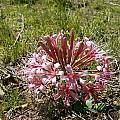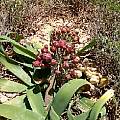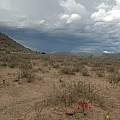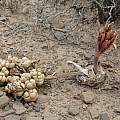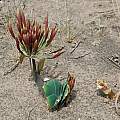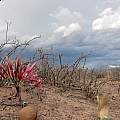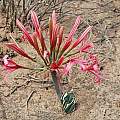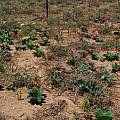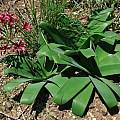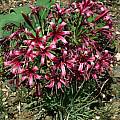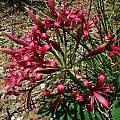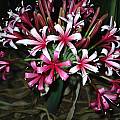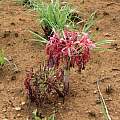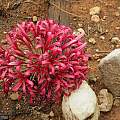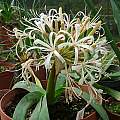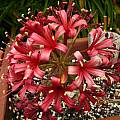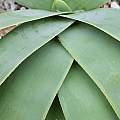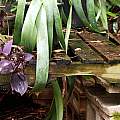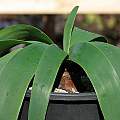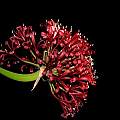Ammocharis coranica (Ker Gawl.) Herb, known as the Karoo Lily, occurs throughout the Karoo and its range extends into the eastern grassland of the summer rainfall area of South Africa at altitudes between 700 and 1500 metres (2200-5000 ft) on flats or in depressions which are seasonally wet, although its habitat is characterised by lengthy dry periods and severe droughts. It extends into Zimbabwe through to Kenya in East Africa. Leaves are arranged in a parallel fashion with the tip of the old leaves truncated, marked by the point where the plant goes dormant in the previous year. Cameron McMaster has provided extremely interesting information about this species in a PBS list post and in an article he wrote for Farmer's Weekly in 2007.
This species is one of the easier species to grow. Seeds germinate easily in cultivation. A choice mix is something well drained with good organic matter (~1:1). Bulbs can grow rather large and will need free root-run before blooming. While in leaf, it responds well to fertilizers and will continue growing until the weather is cool enough for it to enter dormancy. It takes full advantage of water and will break dormancy immediately whenever water is available. After a dry winter dormancy, it only takes 3 days after watering to produce green growths of new leaves! When it dries out, it will go back into dormancy and await the next watering. Plant grows to 35 cm high.
Uluwehi Knecht has found that Ammocharis coranica grows well outdoors in full sun in Honolulu, Hawai'i where it remains evergreen year-round if it is never allowed to dry out. There it is remarkably tolerant of very high humidity (70% rh+) and of high rainfall (3550 mm pa) when grown in 100% coarse horticultural pumice. Under these moist, warm tropical conditions if the leaves are allowed to hang without touching the ground, they can elongate to 1 m in length or more. He hasn't yet bloomed mature plants under these conditions and isn't sure if this is due to lack of winter chilling, as the temperatures generally remained between 60-90 °F / 15-32 °C year-round.
Photos below from Cameron McMaster show this species flowering after fire in grassland in the Cathcart District, flowering in habitat, growing in association with Nerine laticoma ssp. huttoniae in stony Karoo flats, and in fruit in the Willowmore district of the Karoo.
The photos below from Bob Rutemoeller and Mary Sue Ittner showing the habitat and flowering in a Karoo-Namib shrubland vegetation of the Eastern Cape in a very dry year.
The photos below by Christiaan van Schalkwyk show this species in habitat, about 30 km west of Kimberley, South Africa. When in flower they form red pockets of colour in the veld. The flowers open from the outside inwards, about an hour before sunset. If watched closely one can see the actual opening (bursting!) of the buds. The last photo was taken late in the evening, just after the new flowers opened, and show the new lighter and the older darker flowers. This picture was taken in my garden, where the bulbs receive 25 minutes of sprinkler water every sixth day. They bloom regularly, some bulbs up to four times a season. They originally grew in a Kimberley suburb in association with Ipomoea bolusii, a Brachystelma sp., Boophone disticha, and other bulbous species in between grass. Unfortunately this area is now a high density housing complex.
The photos below were taken by Cody Howard from near Octavi, Namibia.
The photos below are of plants in cultivation. Photo 1 by Rogan Roth shows an unusual white-flowered form growing in the collection of the University of KwaZulu-Natal. Photo 2-4 were taken by Uluwehi Knecht. Photo 2 shows a ruby-coloured clone. Photos 3-4 depict the species grown in Honolulu, Hawai'i. Photos 5-6, taken by Nhu Nguyen, show the foliage of the species when grown in full springtime sun in Berkeley, California and the wine-red color form of this species.

